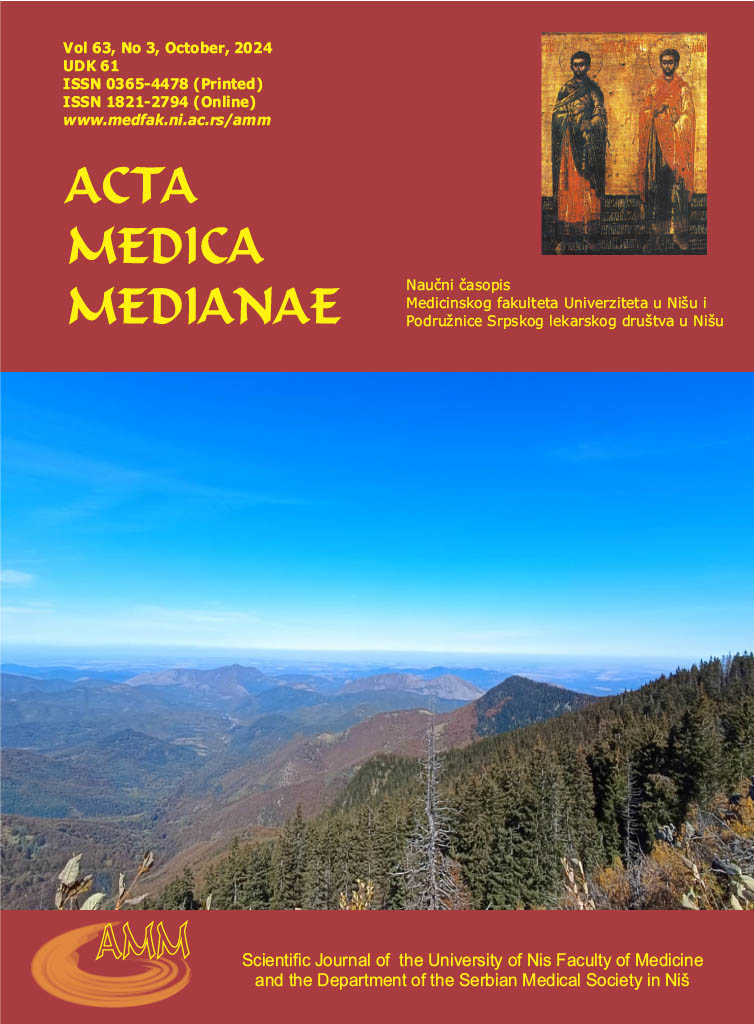THERAPEUTIC DRUG INTOXICATION PATTERN IN THE FEMALE POPULATION DURING THE COVID-19 PANDEMIC IN THE SOUTHEAST SERBIA
Abstract
Drugs are the second cause of human intoxication-related mortality and the first in intoxication records. About 1 in 4 individuals around the world will develop mental illness at some point in their lifetimes. Viral outbreaks, such as the coronavirus disease (COVID-19) pandemic, are associated with short-term and long-term psychological and societal distress. The current review of poisoning patterns in southeast Serbia is imperative. A retrospective cross-sectional study was carried out for two years, from March 2020 to March 2022, to evaluate the prevalence and trends of pharmaceutical drug poisonings. Retrospective data on poisoning cases was collected from the medical records section of the Toxicological Laboratory of the Institute of Forensic Medicine in Niš. Of the 310 cases, 59.35% of intoxications were observed in the female population. The most significant female predominance was observed in the age category 12–19 years (75%). In all age groups over 51, there are more female intoxications than male intoxications by a factor of more than 2.17. In age category 12–19, the most commonly detected drug class was sedatives, followed by analgesics and antiepileptics. In the population over 51, the most frequently detected drug classes in intoxication were sedatives (32.67%), followed by drugs for cardiovascular diseases (15.84%), antiepileptics (13.86%), and antidepressants (11.88%). Women over 51 and in the adolescent age category should be the target group for education and raising awareness about mental health. The prescription of sedatives should always be carefully considered, as this class of drugs is the most common in poisoning.
References
Althobaiti BM, El-Readi MZ, Althubiti M, Alhindi YZ, Alzahrani AR, Al-Ghamdi SS, et al. Patterns of acute poisoning for children during outbreak of Corona virus in Makkah region Saudi Arabia. Front Pediatr 2023; 11:1087095. [CrossRef] [PubMed]
Chrzanowska A, Man N, Darke S, Degenhardt L, Farrell M, Moran L, et al. Unintentional and intentional drug poisoning deaths, Australia, 2012–2016: Drug pattern profile and demographic characteristics. Drug Alcohol Depend 2021; 229(Pt B):109112. [CrossRef] [PubMed]
Dayasiri K, Jayamanne SF, Jayasinghe CY. Accidental and Deliberate Self-Poisoning with Medications and Medication Errors among Children in Rural Sri Lanka. Emerg Med Int 2020;2020:9872821. [CrossRef] [PubMed]
Descamps AMK, Vandijck DM, Buylaert WA, Mostin MA, Paepe PD. Characteristics and costs in adults with acute poisoning admitted to the emergency department of a university hospital in Belgium. PLoS One 2019;14(10):e0223479. [CrossRef] [PubMed]
Gong Y, Liu X, Zheng Y, Mei H, Que J, Yuan K, et al. COVID-19 Induced Economic Slowdown and Mental Health Issues. Front Psychol 2022; 13:777350. [CrossRef] [PubMed]
Haoka T, Sakata N, Okamoto H, Oshiro A, Shimizu T, Naito Y, et al. Intentional or unintentional drug poisoning in elderly people: retrospective observational study in a tertiary care hospital in Japan. Acute Med Surg 2019;6(3):252–8. [CrossRef] [PubMed]
Holmes EA, O’Connor RC, Perry VH, Tracey I, Wessely S, Arseneault L, et al. Multidisciplinary research priorities for the COVID-19 pandemic: a call for action for mental health science. Lancet Psychiatry 2020;7(6):547–60. [CrossRef] [PubMed]
Jonassen R, Hilland E, Harmer CJ, Abebe DS, Bergem AK, Skarstein S. Over-the-counter analgesics use is associated with pain and psychological distress among adolescents: a mixed effects approach in cross-sectional survey data from Norway. BMC Public Health 2021;21(1):2030. [CrossRef] [PubMed]
Kessler RC, Angermeyer M, Anthony JC, DE Graaf R, Demyttenaere K, Gasquet I, et al. Lifetime prevalence and age-of-onset distributions of mental disorders in the World Health Organization’s World Mental Health Survey Initiative. World Psychiatry 2007;6(3):168–76. [PubMed]
Khan TS, Boyle A, Talbot S. Unintentional Drug-related Deaths in Cambridgeshire: A Retrospective Observational Study. Cureus 2020;12(1):e6750. [CrossRef] [PubMed]
Kiang MV, Acosta RJ, Chen YH, Matthay EC, Tsai AC, Basu S, et al. Sociodemographic and geographic disparities in excess fatal drug overdoses during the COVID-19 pandemic in California: A population-based study. Lancet Reg Health Am 2022; 11:100237. [CrossRef] [PubMed]
Lee JS, Cha YS, Yeon S, Kim TY, Lee Y, Choi JG, et al. Changes in Diagnosis of Poisoning in Patients in the Emergency Room Using Systematic Toxicological Analysis with the National Forensic Service. J Korean Med Sci 2021;36(18):e118. [CrossRef] [PubMed]
Marcheselli F, Brodie E, Yeoh SN, Pearce N, McManus S, Sadler K, et al. Mental health of children and young people in England, 2017. London: NHS [Internet]. 2018;
Mbeledogu CNA, Cecil EV, Millett C, Saxena S. Hospital admissions for unintentional poisoning in preschool children in England; 2000–2011. Arch Dis Child 2015;100(2):180–2. [CrossRef] [PubMed]
McManus S, Bebbington P, Jenkins R, Brugha T. Mental Health and Wellbeing in England: the Adult Psychiatric Morbidity Survey 2014. McManus S, Bebbington P, Jenkins R, Brugha T, editors. 2016 [cited 2023 May 8];
Mégarbane B, Oberlin M, Alvarez JC, Balen F, Beaune S, Bédry R, et al. Management of pharmaceutical and recreational drug poisoning. Ann Intensive Care 2020;10(1):157. [CrossRef] [PubMed]
Mental health [Internet]. [cited 2023 May 8]. Available from: https://www.womenshealth.gov/mental-health
Nistor N, Jitareanu C, Frasinariu OE, Ciomaga IM, Rugina AL, Streanga V. Epidemiologic profile and triggering factors of voluntary poisoning in teenagers. Medicine 2017;96(5) :e5831. [CrossRef] [PubMed]
Saitz R, Horton NJ, Samet JH. Alcohol and medication interactions in primary care patients: common and unrecognized. Am J Med 2003;114(5):407–10. [CrossRef] [PubMed]
Stanca S, Bostan I, Stanca HT, Danielescu C. Updates in teenage acute intentional self-poisonings. Romanian [Internet]. 2021; Available from: http://eprints.bmsu.ac.ir/9559/1/Challenging%20of%20COVID-19%20crisis%20in%20the%20Emergency%20Department.pdf#page=114
Tyrrell EG, Orton E, Sayal K, Baker R, Kendrick D. Differing patterns in intentional and unintentional poisonings among young people in England, 1998–2014: a population-based cohort study. J Public Health 2016;39(2):e1–9. [CrossRef]
Women’s mental health facts [Internet]. Agenda Alliance. [cited 2023 May 8]. Available from: https://www.agendaalliance.org/our-work/projects-and-campaigns/womens-mental-health-facts/

